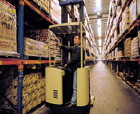Feb. 3, 2003 – RedPrairie is upgrading its warehouse management system (WMS) to give customers a way to transition from bar codes to radio frequency identification tags. The next version of the company’s DLx Warehouse product, due out at the end of this quarter, will be able to handle data from both bar codes and RFID tags.
“Our customer base tends to be multi-site, and switching over to RFID all at once is impractical,” says Noah Dixon, product manager for visibility and warehouse functions at RedPrairie (formerly McHugh Software). “This release will allow our customers to use paper bar coding and RFID solutions side by side for a period of time.”
The system links the unique ID on a bar code with the unique ID on an RFID tag. Once the link is established, staff can scan either the bar code or the RFID tag from then on. The system is being design specifically to track CHEP pallets.
CHEP is introducing pallets that will have two RFID tags each. Each tag will carry an Electronic Product Code (EPC). CHEP will use one EPC internally to track pallets and offer customers the option of using the other to track their goods. CHEP has linked the two tags to the pallet by writing a third identifier to both tags. RedPrairie’s system will be able to use the EPC tags and the CHEP identifier.
The initial aim is to give companies a way to automate the process of counting what’s been shipped out of or received into the warehouse. That data can be checked against what was supposed to be shipped or received. The RFID capability will also be integrated into cycle counting and other WMS functions.
Dixon says the system can track either pallets or pallets and cases, but initially he doesn’t expect customers to track cases, simply because the RFID tags are still too expensive. He also says the equipment is still limited.
“There are devices that handle both [RFID tags and bar codes] at the same time, but the scanners that we will be using don’t do long range scanning,” he says. “The maximum read range is about five feet, and for a pallet warehouse, that’s less than ideal.”
RedPrairie, based in Waukesha, Wisc., also plans to introduce, at its user conference in April, a visibility tool called LENS, which will pull data from the WMS and display it, so that companies can track CHEP pallets as they move through the supply chain.
By the end of the year, RedPrairie plans to further enhance the system by offering automated scanning of location. The idea is that a tag would be placed at a warehouse bay or rack, and a reader on a forklift would scan it automatically. The WMS would then match the identifier on the pallet to the one on the location.
Dixon says RedPrairie is looking for a hardware vendor that can develop a system that will make it possible for readers on forklifts to identify locations accurately, without interfering with the normal operations of the forklift. The company wants to offer a turnkey solution.
Manhattan Associates recently announced that it was adding RFID capabilities to its own WMS (see Manhattan Associates Gets RFID). Many experts believe that warehouses will be among the first areas to benefit from the use of RFID for tracking goods in the supply chain.


